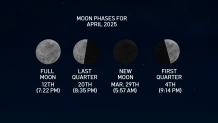
A meteor of the lyrids in the sky is seen on April 22, 2020 in Schermbeck, Germany.
Keep an eye on the night sky for some celestial events
What's happening in the skies over North Texas this month? April holds some spectacular sights in the night sky. Check out the list below.
Watch NBC 5 free wherever you are
VISIBLE PLANETS THIS MONTH

Get top local stories in DFW delivered to you every morning with NBC DFW's News Headlines newsletter.
Finding Mars
Mars will appear not far from the “twin stars” of Pollux and Castor, in the Gemini constellation. During the evening hours, it is high in the southern sky at the start of the month. It sinks down into the southwest sky by the end of the month.
Looking for Jupiter
Local
The latest news from around North Texas.
Jupiter is high in the western sky, inside the constellation Taurus, early in the month. Each night, it gradually lowers in the sky. By the end of the month, it's in the west-northwest sky.
The Morning Cluster of Planets
Mercury, Venus, and Saturn are clustered near the rising Sun this month, making them nearly impossible to view safely. Neptune is also located in this cluster, but it can never be seen without binoculars or a strong telescope.
Early in the month, Venus is the only planet that may be visible. Due to its extreme brightness, Venus is often bright enough to be seen in the morning hours before sunrise.
MONTHLY METEOR SHOW: THE LYRIDS
The April Lyrids are expected to be active between April 14 and April 30, peaking on April 21-22. At the peak, about 18 meteors per hour will be visible.
The expected rate and brightness of these meteors are low enough that Dallas-Fort Worth Metroplex watchers will have little chance of seeing these meteors. You are likelier to see them if you have an unobstructed view with clear skies in a very dark place far from any urban light sources.
The Lyrids will appear to radiate from near the Lyra constellation, which contains the bright star Vega. Look above the northeastern horizon after about 10:30 p.m. CDT.

The Lyrids are caused by comet C/1861 G1 (Thatcher) debris entering the Earth's atmosphere at 110,000 miles per hour. The comet is expected to be visible from Earth again in 2276.
FULL PINK MOON
The April full moon, known as the Pink Moon, will create a fully illuminated delight on April 12 at 7:22 p.m. CDT.

The name Pink Moon comes from a type of pink flower known as Phlox subulata, also called pink or moss phlox, which blooms in spring.

Also, catch the other phases of the moon this month. By the way, on April 27 at 11:05 a.m. CDT, the moon will be at perigee, its closest to the Earth for this orbit at 221,901 miles. On April 13 at 5:48 p.m. CDT, the moon will be at apogee, its farthest from the Earth for this orbit at 252,460 miles.
WHEN DOES THE INTERNATIONAL SPACE STATION FLY OVER NORTH TEXAS?
The International Space Station will make flybys across the North Texas sky this month. The ISS appears as a fast-moving star across the night sky.

The International Space Station rotates around the Earth at 17,500 mph. It rotates about its center of mass at a rate of about 4 degrees per minute, so it will complete a full rotation once per orbit. This allows it to keep its belly towards the Earth. One revolution takes about 90 minutes (16 per day).
The International Space Station lies at an altitude of 250 miles above the Earth, which is 1.32 million feet. Most commercial airplanes fly between 33,000 and 42,000 feet.
HOW FAR WILL THE EARTH TRAVEL AROUND THE SUN THIS MONTH?
First, the Earth's spin is constant, but the speed depends on the latitude you are located at. For example, at the equator, the speed is about 1,037 mph.
Earth's spin, of course, is not the only motion we have in space. Our orbital speed around the sun is about 67,000 mph. That's the equivalent of traveling from London to New York in about three minutes.

In our orbital voyage around the sun, we've traveled 194.64 million miles by the end of April. Only 389.36 million miles to go!
Please enjoy these events in the night sky this month. Until then, Texans, keep looking up!



